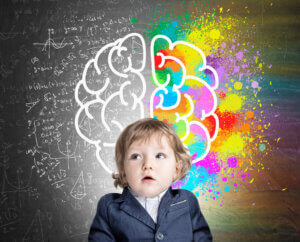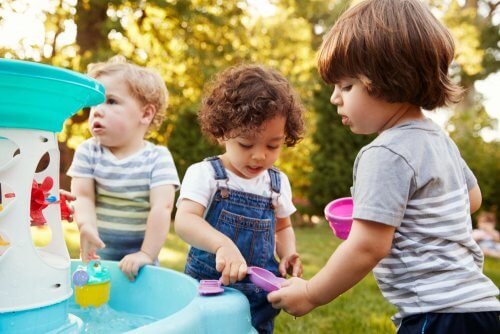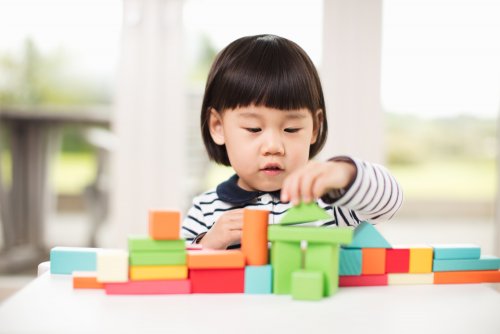Heredity and the Environment in Children's Development


Written and verified by the psychologist Ana Couñago
From the moment of birth, children develop their potential and abilities in a progressive way. In addition, little by little, they adapt to the physical, social, and cultural environment that surrounds them and in which they’re destined to grow. In other words, heredity and the environment play a very important role in child development.
Therefore, we can say that the acquisition of human capacities is based on the direct interaction between genetic predisposition and the upbringing, learning, and education that individuals receive.
“Every child needs at least one adult who is irrationally crazy about him or her.”
– Urie Bronfenbrenner –
Heredity and the environment in children’s development
As we mentioned above, the relationship between innate factors and acquired factors, between heredity and the environment, influences children’s development. But what’s the definition of each of these concepts?

- Heredity. It’s the chromosomal and genetic endowment that parents transmit to their children, meaning that certain physical, physiological, morphological, and behavioral characteristics are innately given.
- Environment. It refers to the environment in which a person lives and grows, including society, culture, and the influence of people who are in permanent contact with the individual.
Therefore, children are born with a certain potential that they inherit from their parents and develop their capacities, to a greater or lesser extent, depending on the environment and the learning opportunities that exist in it.
Thus, a child with a high genetic potential isn’t going to take enough advantage of it if they grow up in a poor environment that offers little to no stimulation. In contrast, another child with a lower innate potential can significantly increase their performance if they grow up in or are exposed to a stimulating environment.
“There are only two lasting bequests we can hope to give our children. One of these is roots, the other, wings.”
– Johann Wolfgang von Goethe –
The characteristics of development
With this in mind, we should note that human development is considered a process that is:
- Dynamic. Due to the interaction between the person and a changing environment.
- Adaptive. Because it’s necessary to learn to adapt and adjust the responses to the situations the environment poses.
- Continuous. Since it’s a process that takes place throughout the life cycle.
- Comprehensive. Because all human capacities develop and evolve.
- Unique and unrepeatable. Since each person develops in a different way according to lived experiences.
- Universal. Because everyone undergoes this process.

The margin for reaction in child development
All children have a margin of reaction. In other words, an ability to improve their potential due to the intervention of the immediate environment. Thus, you should never give up on a child’s education and learning. Regardless of their innate characteristics, all children can achieve optimal development within their possibilities.
But, obviously, it’ll be easier for a child with a genotype that allows them a greater margin of reaction. In short, we can unquestionably conclude that both factors, heredity and the environment, are essential for children’s proper development.
Thus, mothers, fathers, teachers, and educators have the responsibility of offering a stimulating environment, which is always positive and beneficial for child development.
“A child is like a butterfly in the wind. Some can fly higher than others, but each one flies the best it can. Why compare one against the other? Each one is different, each one is special, each one is beautiful.”
– Anonymous –
From the moment of birth, children develop their potential and abilities in a progressive way. In addition, little by little, they adapt to the physical, social, and cultural environment that surrounds them and in which they’re destined to grow. In other words, heredity and the environment play a very important role in child development.
Therefore, we can say that the acquisition of human capacities is based on the direct interaction between genetic predisposition and the upbringing, learning, and education that individuals receive.
“Every child needs at least one adult who is irrationally crazy about him or her.”
– Urie Bronfenbrenner –
Heredity and the environment in children’s development
As we mentioned above, the relationship between innate factors and acquired factors, between heredity and the environment, influences children’s development. But what’s the definition of each of these concepts?

- Heredity. It’s the chromosomal and genetic endowment that parents transmit to their children, meaning that certain physical, physiological, morphological, and behavioral characteristics are innately given.
- Environment. It refers to the environment in which a person lives and grows, including society, culture, and the influence of people who are in permanent contact with the individual.
Therefore, children are born with a certain potential that they inherit from their parents and develop their capacities, to a greater or lesser extent, depending on the environment and the learning opportunities that exist in it.
Thus, a child with a high genetic potential isn’t going to take enough advantage of it if they grow up in a poor environment that offers little to no stimulation. In contrast, another child with a lower innate potential can significantly increase their performance if they grow up in or are exposed to a stimulating environment.
“There are only two lasting bequests we can hope to give our children. One of these is roots, the other, wings.”
– Johann Wolfgang von Goethe –
The characteristics of development
With this in mind, we should note that human development is considered a process that is:
- Dynamic. Due to the interaction between the person and a changing environment.
- Adaptive. Because it’s necessary to learn to adapt and adjust the responses to the situations the environment poses.
- Continuous. Since it’s a process that takes place throughout the life cycle.
- Comprehensive. Because all human capacities develop and evolve.
- Unique and unrepeatable. Since each person develops in a different way according to lived experiences.
- Universal. Because everyone undergoes this process.

The margin for reaction in child development
All children have a margin of reaction. In other words, an ability to improve their potential due to the intervention of the immediate environment. Thus, you should never give up on a child’s education and learning. Regardless of their innate characteristics, all children can achieve optimal development within their possibilities.
But, obviously, it’ll be easier for a child with a genotype that allows them a greater margin of reaction. In short, we can unquestionably conclude that both factors, heredity and the environment, are essential for children’s proper development.
Thus, mothers, fathers, teachers, and educators have the responsibility of offering a stimulating environment, which is always positive and beneficial for child development.
“A child is like a butterfly in the wind. Some can fly higher than others, but each one flies the best it can. Why compare one against the other? Each one is different, each one is special, each one is beautiful.”
– Anonymous –
All cited sources were thoroughly reviewed by our team to ensure their quality, reliability, currency, and validity. The bibliography of this article was considered reliable and of academic or scientific accuracy.
- Atehortúa, N. G., & Gallego, M. M. Á. (2020). Aproximación teórica a las estrategias de acompañamiento en el ambiente familiar y escolar. Cultura, Educación y Sociedad, 11(1), 151-166. https://dialnet.unirioja.es/servlet/articulo?codigo=7823591
- García-Gómez, A.M. (2009) ¿Cómo nos influye la herencia y el ambiente? Contribuciones a las Ciencias Sociales, (6). Recuperado de: http://www.eumed.net/rev/cccss/06/amgg.htm
- Deary, I.J., Cox, S.R. & Hill, W.D. Genetic variation, brain, and intelligence differences. Mol Psychiatry 27, 335–353 (2022). https://www.nature.com/articles/s41380-021-01027-y
- Merino-Muñoz, M. (2010). Características generales y factores que intervienen en el niño/a hasta los 6 años de edad. Temas para la educación: revista digital para profesionales de la enseñanza, (7).
- Monks, F. J. (1996). Herencia y ambiente: una aproximación interactiva hacia el talento. Revista de Psicología, 14(2), 111-128. https://revistas.pucp.edu.pe/index.php/psicologia/article/view/4565
- Plomin, R., & von Stumm, S. (2018). The new genetics of intelligence. Nature reviews. Genetics, 19(3), 148–159. https://pubmed.ncbi.nlm.nih.gov/29335645/
- Romero-Castillo, J. (2022). Conceptualización neuropsicológica de las altas capacidades infantiles: reflexión histórica sobre un tema de creciente actualidad. Cuadernos de Neuropsicología/Panamerican Journal of Neuropsychology, 16(2). https://www.cnps.cl/index.php/cnps/article/view/504
- Sastre-Riba S, Ortiz T. Neurofuncionalidad ejecutiva: estudio comparativo en las altas capacidades. Rev. Neurol 2018; 66 (Supl. 1):S51-S56. https://neurologia.com/articulo/2018026
This text is provided for informational purposes only and does not replace consultation with a professional. If in doubt, consult your specialist.








